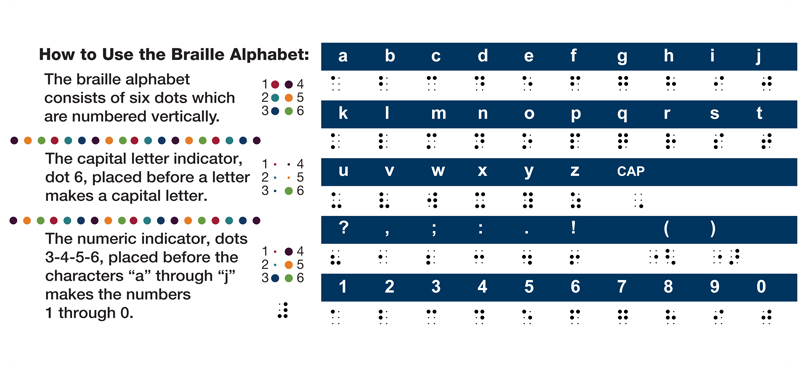There are a number of resources available to teach people who are sighted the basics of the braille alphabet. These include websites, activities, braille cards, and lesson suggestions for general education classrooms. They are not intended to teach the full braille code, but rather to raise awareness at an introductory level.

We invite you to explore the following:
Braille Basics
Braille Basics, BANA
This single-page document provides information about the braille cell, the braille alphabet, common punctuation marks, and braille numbers.
Braille Lessons for People Who Are Sighted
Basic Braille by Sight Reading Series, Hadley
These short videos present the alphabet, numbers, punctuation and more in sequential lessons.
Music
We love this catchy tune to introduce the braille alphabet and we think you’ll love it too! Includes the lyrics.
Activities for Sighted School Children to Learn About Braille
This website from American Printing House for the Blind (APH) is designed to introduce sighted children to the world of braille. It includes the following sections: What is Braille?; Braille Literacy; Braille Resources; Games and Secret Messages; Louis Braille; AFB’s Helen Keller Kids Museum Online.
Royal National Institute of the Blind (RNIB) has a number of resources that can be used in schools to help teach children about what braille is, the history of braille and how it is used.
These pages from the Professional Development and Research Institute on Blindness (PDRIB) include braille activities, braille coloring pages, braille dot coloring, braille games to make, and more.
Braille Chart for Sighted Classmates Learning Braille Visually
Young children can use this color-coded chart to write their names.
Braille Connect the Dots, Blind Foundation (New Zealand)
Braille Alphabet Charts
Braille Alphabet Cards (National Braille Press)
This visual representation of the braille alphabet without contractions can be downloaded as a PDF file.
This two-page document from PRCVI (Provincial Resource Centre for the Visually Impaired) shows two views of the braille alphabet: dots in each braille cell, as well as the view on a braillewriter.
Additional Resources










